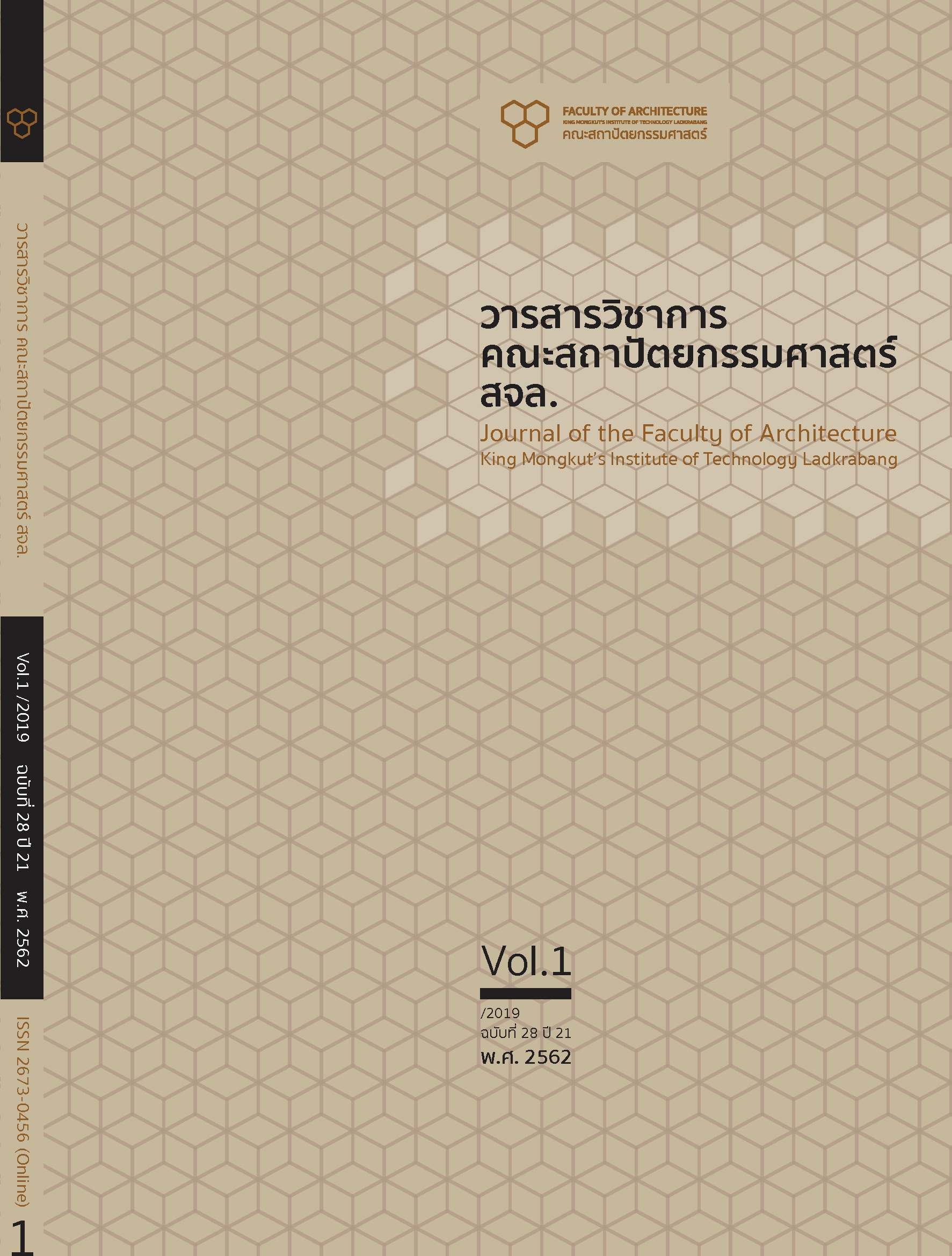The Use of Design Elements for Area Based Development in Thasala District, Nakhon Si Thammarat Province
Main Article Content
Abstract
บทคัดย่อ
บทความนี้เป็นส่วนหนึ่งของโครงการวลัยลักษณ์บูรณาการท่าศาลาเมือง น่าอยู่ นำแนวคิด ชุมชนเป็นฐานโดยใช้กระบวนการทางการวิจัยเข้ามามีส่วนร่วมในการศึกษาและพัฒนาพื้นที่ริมทะเลบนชายหาดท่าสูง อำเภอท่าศาลา จังหวัดนครศรีธรรมราช โดยงานวิจัยนี้มีวัตถุประสงค์เพื่อหาแนวความคดิ อัตลักษณ์ชุมชนที่มีรูปแบบที่เหมาะสมในการพัฒนาเชิงพื้นที่ด้วยความคิดสร้างสรรค์ ตลอดจนการบูรณาการองค์ความรู้กับชุมชนให้เกิดประโยชน์อย่างยั่งยืน ศึกษาภาคสนามโดยการสังเกตแบบมีส่วนร่วม สัมภาษณ์เชิงลึก และการสนทนากลุ่ม นำข้อมูลมาวิเคราะห์แนวความคิดทางการออกแบบสร้างสรรค์โดยมุ่งสร้างค่านิยมร่วมให้เห็นคุณค่าของชุมชน และภูมิปัญญาของพื้นที่ส่งผ่านองค์ประกอบทางการออกแบบสร้างสรรค์ผลงานบนพื้นที่ว่างบริเวณอาคารอเนกประสงค์ส่วนกลางที่มีความรกร้าง ให้พื้นที่รกร้างเกิดความงามเพื่อทำให้ชุมชนสำนึกหวงแหนพื้นที่มากขึ้น ผลที่ได้รับจากการพัฒนาเชิงพื้นที่ พบว่าพื้นที่รกร้างมีความสะอาดเพิ่มขึ้น และมีผู้เข้าไปใช้ประโยชน์ในการจัดกิจกรรมริมชายหาดท่าศาลามากขึ้น ทั้งกิจกรรมเชิงศาสนาของชาวมุสลิม กิจกรรมท่องเที่ยวเชิงกีฬา กิจกรรมพักผ่อนหย่อนใจ ตลาดนัดร้านค้ารวมถึงกิจกรรมการท่องเที่ยวเชิงนิเวศ
คำสำคัญ: พัฒนาเชิงพื้นที่ องค์ประกอบทางการออกแบบ อัตลักษณ์
Abstract
This article is part of Walailak Applied Project, Thasala Smart and Smile City under the community–based concept. A purposes were investigatinge and developing the coastal area at Thasung Beach, in Thasala, Nakhon Sri Thammarat Province. The study aimed to shed light on a suitable approach for area development, using creative design along with the community’s identity and also encouraged the integration of academic knowledge and local wisdom for sustainable development. The study comprised field data collection through participatory observations, in-depth interview and group discussions. The data was analyzed to find a creative design concept gearing toward shaping up the community shared the pride of the local wisdom through the application of art composition on the communal building. This shared sense of area ownership also raised awareness on waste management in the public area. The project outcome revealed cleanness of the desolate areas as well as more beach activities of several kinds arranged, such as Muslim activities, sports tourism, recreational activities, markets, and ecotourism.
Keywords: Area-based Development, Design Elements, Identity
Article Details
This work is licensed under a Creative Commons Attribution-NonCommercial-ShareAlike 4.0 International License.
Copyright Transfer Statement
The copyright of this article is transferred to Journal of The Faculty of Architecture King Mongkut's Institute of Technology Ladkrabang with effect if and when the article is accepted for publication. The copyright transfer covers the exclusive right to reproduce and distribute the article, including reprints, translations, photographic reproductions, electronic form (offline, online) or any other reproductions of similar nature.
The author warrants that this contribution is original and that he/she has full power to make this grant. The author signs for and accepts responsibility for releasing this material on behalf of any and all co-authors.
References
กรวรรณ รุ่งสว่าง และ สุพักตรา สุทธสุภา. (2560). แนวคิดและองค์ประกอบของชุมชนเมืองสร้างสรรค์ ตามลักษณะท้องถิ่นในประเทศไทย. ในการประชุมวิชาการสถาปัตย์กระบวนทัศน์. (หน้า 21-42). กรุงเทพฯ: มหาวิทยาลัยศิลปากร.
จิรันธนิน กติกา (2560). โครงข่ายชุมชนจากการวางผังเมืองสมัยใหม่จากการศึกษาเปรียบเทียบระหว่างชุมชน โดยยามะ จังหวัดโตเกียว และชุมชนบนถนนนิมมานเหมินทร์ จังหวัดเชียงใหม่. วารสารวิชาการคณะสถาปัตยกรรมศาสตร์ สจล. 24(2), 24-36.
นิภาพรรณ เจนสันติกุล. (2557). พัฒนาชุมชนเมืองและบทสำรวจเบื้องต้น. วารสารมนุษยศาสตร์และสังคมศาสตร ์มหาวิทยาลัยมหาสารคาม. 33(5), 81-91.
ปัจฉิมา ธนสันต. (2554). บทบรรณาธิการ. วารสารทรัพย์สินทร์ทางปัญญา. 7(3), 2.
แมนฤทธิ์ เต็งยะ. (2559). จากวัฒนธรรมกราฟฟิตีสู่งานสตรีทอาร์ตในประเทศไทย. วารสารวิชาการ Veridian E-Journal มหาวิทยาลัยศิลปากร. 9(2), 2424-2436.
รุจิโรจน์ อนามบุตร. (2547). เมืองน่าอยู่และประหยัดพลังงาน. ในการประชุมสัมมนาการออกแบบและวางผังชุมชนให้เป็นเมืองน่าอยู่และประหยัดพลังงาน. กรุงเทพฯ: สมาคมสถาปนิกชุมชนเมืองไทย.
Borchardt, A. (2013). The Creative City: Place, Creativity & People, Glasgow and Portland. (Research Term),
Glasgow of the Mackintosh School of Architecture, the Glasgow School of Art. Retrieved from:
https: / / issuu. com/ thecreativecity/ docs/ creative-city.
Sawangchot, V. (2016). Creative City and the Sustainable Life: A Study on the Making of Cultural Spaces in Osaka and Bandung. Journal of Urban Culture Research. 12(12), 54-69.
UNCTAD. (2008). Creative Economy Report. Retrieved from: https://unctad.org/en/docs/ditc20082cer_en.pdf.
UNESCO. (2016). Creative Cities Network. Retrieved from: https://en.unesco.org/creative-cities/home.
UNESCO. (2004). What is the Creative Cities Network from UNESCO Creative Cities Network?. Retrieved from: https://en.unesco.org/creative-cities/content/about-us.


